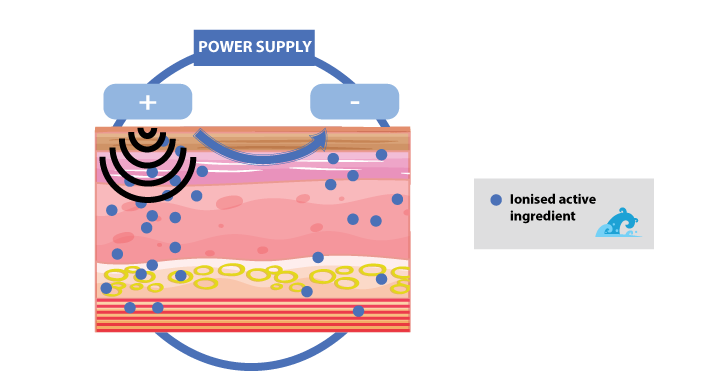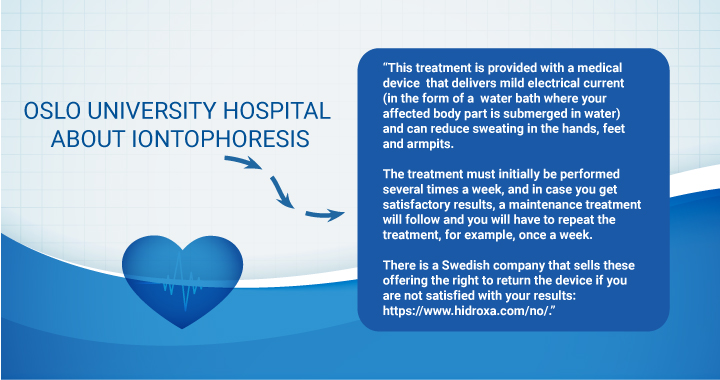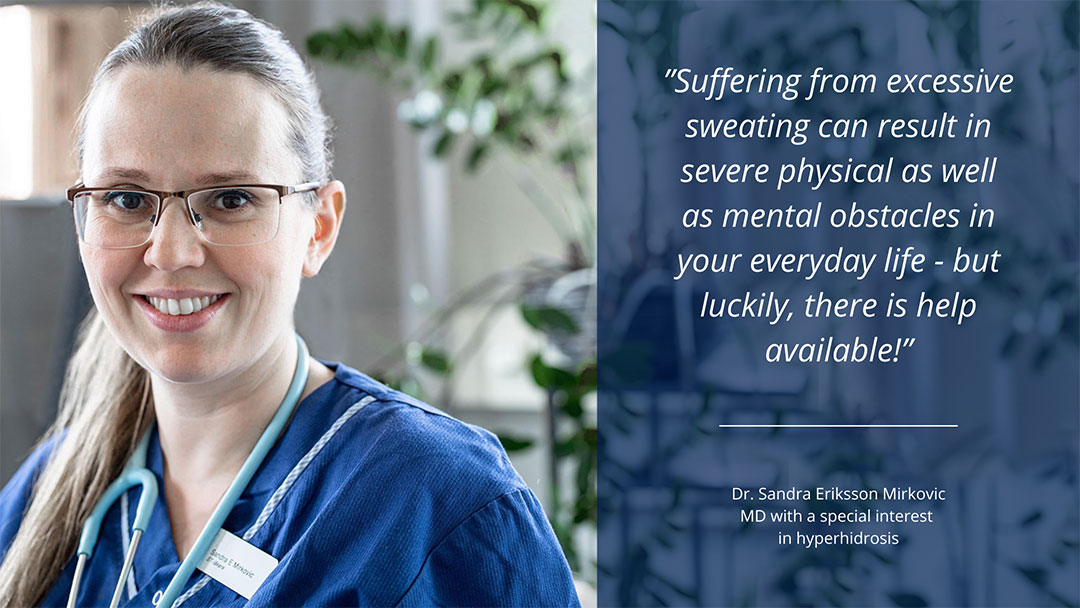Iontophoresis is a safe, painless, and effective treatment that a person can use to reduce excessive sweating (hyperhidrosis) of the hands, feet, and armpits. Research shows that almost 3-5% of the world’s population has this medical condition.
People suffering from hyperhidrosis are constantly looking for new treatment options that could help them reduce sweating and make life a little easier. For decades, people have used tap water iontophoresis to treat hyperhidrosis.
Although the Internet has helped spread information about this method within the hyperhidrosis community, most patients are still unaware of this method.
If over-the-counter antiperspirants and home remedies do not curb the sweating problem, you might turn to medical treatments. With several options to choose from, iontophoresis is a non-invasive, painless, and relatively inexpensive treatment that is suitable for patients to use at home.
You might wonder if iontophoresis is really effective? Considering the effectiveness that customers got using our device and the research that has been done – the simple answer is yes. But before investing your time and money in iontophoresis, you should know how the treatment works, potential side effects, and what results you can expect. So, let’s dig into this.
What is iontophoresis?
Iontophoresis machines are one of the most efficient ways to treat hyperhidrosis. This treatment is suitable for treating hyperhidrosis of the hands, feet, underarms. If the necessary accessory is available, for example, Hidroxa iontophoresis face mask, treatment of craniofacial hyperhidrosis is possible. Please note that treating craniofacial hyperhidrosis with an iontophoresis face mask is still experimental. Nevertheless, we had satisfied customers that say it helps them to manage their sweating. Many patients have achieved great success, but the truth is that it will require some work until satisfactory results are achieved.
The positive effect of iontophoresis is seen in reducing uncontrollable, excessive sweating since the 1940s. In recent decades, many international studies and case studies have investigated iontophoresis and its positive effect on the treatment of hyperhidrosis. The treatments tend to be very efficient with minimal side effects. The success rate ranges between 80-90% of treated patients while numerous reviews of our happy customers testify the efficiency of this treatment.
The main advantages of this method are:
– the reduction of the excessive sweating
– it is a non-invasive, needle-free, drug-free method
– the efficiency of iontophoresis treatment for hyperhidrosis generally ranges between 80%-90% of people treated
– easy to use & clinically proven
How does iontophoresis work?
Iontophoresis is often recommended to people who have tried prescription antiperspirants but without success and need more effective treatment. It’s a medical device that delivers a mild electrical current while your affected body part is submerged in the water. Make sure that the water covers the area you wish to treat and no more than that. For example, the palms of the hands.
Before treatment, you will need to turn on the device and place your hands or feet in trays filled with lukewarm water. To treat armpits/face, keep water-soaked sponge pads placed under the armpits or wear a face mask soaked in water. Then a small current passes through the water. Tap water is used as an electrically conductive medium between the electrode and the skin. Accordingly, the use of tap water-soaked sponge pouches is to avoid direct skin contact with the electrodes and thus achieves a greatly homogenous current flow through the skin. The current is conducted in one direction for a certain time, and then vice versa during the same time.

We don’t known exactly how iontophoresis treatments work, but there are several theories:
- Electric current and mineral particles in the water work together to thicken the outer layer of the skin, blocking the sweat
- The current can interrupt the normal transmission of the nerve, can disrupt the functioning of your sweat glands
- It decreases the pH value in the sweat gland, which makes it more acidic and reduces the amount of sweat produced
Iontophoreisis treatment
There are no confirmed hypotheses about how iontophoresis treatment works. What we do know is that this treatment significantly reduces excessive sweating. Usually, you need to perform treatments several times a week (preferably every day). Some of our customers saw the first results after only two weeks.
Once the patient achieves the desired effect, maintenance treatments will occur. At that point, treatments need to be performed less frequently, usually about 1-2 times a week or before important events, such as appointments or a date. In some cases, it can even completely eliminate sweating, and dryness can last up to a month. The treatment works within a relatively short period, but it is very individual and depends on a lot of factors, so you will have to be patient.
What is the difference between the constant current and the pulsed current?
Hidroxa iontophoresis device has a choice of constant (CC) and pulsed current (PC). From our experience, most patients prefer pulsed current over direct because the treatment is more comfortable, although the constant current is generally considered more effective.
So, you’re probably wondering, which should I choose, constant or direct current? It depends. Not all patients will find constant current uncomfortable, but in any case, we recommend using PC at the beginning. If the patient performs iontophoresis and feels discomfort with direct current, switching to pulsed current would make the treatment much more comfortable. This way people can tolerate higher current values. This means that you will not achieve results if you cannot tolerate the current, so PC would be more effective in the long run. If the PC is not effective, then it is usually recommended to switch and try CC as a last resort.
The current strength should be adjusted according to your comfort level. In case you are an adolescent, have sensitive skin, or secondary skin conditions, choose a pulsed current. This setting will provide results with minimal discomfort but might take longer to achieve results. Using a pulsed current is essential when treating excessive sweating of the face.
Collaboration with Oslo University Hospital (Oslo universitetssykehus)
This method to tackle excessive sweating has been used by healthcare professionals in hospitals, clinics, and dermatology departments around the world. Hidroxa supplies many hospitals in the Nordic region with iontophoresis machines. Among them is the University Hospital of Oslo, which encourages its patients to try iontophoresis and see for themselves the effects of iontophoresis.

You can carry out the treatment yourself, in the privacy of your own home, without any medical supervision. The thing is, some people want to see how to perform treatments and whether it works for them before they buy their iontophoresis device.
Our iontophoresis machine has the CE mark and is completely designed for home use. The machines we sell at hidroxa.com are the same devices that use professionals in hospitals, clinics, and dermatology departments. You don’t need a prescription for using iontophoresis. If you buy our #HidroxaSE20 iontophoresis machine, we offer 50 days money-back guarantee. That means you can try iontophoresis at home and if you don’t get satisfactory results, you can easily return it. (See our return policy).
Does it work for everyone?
Nothing works 100% for everyone. In the majority of cases, this treatment is effective with significantly drier hands and/or feet after only 2 weeks. Each treatment lasts approx. 20 to 30 minutes.
There is no magic wand that will tell you what works for you and how many treatments need to be done for some serious results. Initially, we recommend performing one treatment every day for two-three weeks. After this, when you start feeling the effect, you will need to repeat the sessions as needed weekly/monthly. It needs to be repeated regularly to remain effective.
In the beginning, using an iontophoresis machine can seem to be overwhelming. So, it will require some work and you have to be consistent until you reach your satisfactory level of dryness.
Is iontophoresis safe? What are the potential side effects?
Generally, iontophoresis is a safe procedure, especially when you compare it to other hyperhidrosis treatments, such as anticholinergics or surgery. You will not feel pain from the treatment, but you may experience a mild tingling sensation on the skin during the treatment. Additionally, the electric current is not strong enough to cause any serious damage to your skin or a harmful shock.
Anti-sweat machines are a proven method for managing hyperhidrosis with minimal side effects. Excessive dryness or mild skin irritation are the most common complaints.
Some people can also experience:
- Itching of the treated area shortly after treatment.
- Skin blisters, redness can occur if the intensity of the current was too high or its duration was too long
- You may feel a slight burning sensation if you touch the electrodes
- Feeling of electric shock if you remove your arms or legs from the trays halfway through the treatment
- Moderate skin thickening as a cause of frequent treatments, which means you should do them less often
- If you have eczema, it can make the condition worse. Always being wet from hyperhidrosis could cause eczema, so make sure it is under control before starting iontophoresis
There are no long-term side effects. Proper device operation and following instructions that come with the device are essential to minimize the occurrence of these problems. Before you commence the session, don’t forget to take off all metal jewelry before the treatment. Avoid removing the electrodes or disconnecting the cables until you turn off the device. You should also avoid touching the metal plates that are in the baths, as this may result in a burn.
Is iontophoresis the right treatment for me? Rule out underlying medical conditions
Sometimes, hyperhidrosis occurs due to an underlying medical condition. If it happens for no reason – it is called primary, otherwise, it is secondary hyperhidrosis. If you have a proper treatment for the underlying medical condition, it often helps reduce your sweating. So, before you opt for iontophoresis, always first consult your doctor who will identify any possible underlying medical condition that may be the cause of excessive sweating.
You should not use iontophoresis if you fall into any of these categories, as this may increase the risk of side effects and complications:
- Women who are pregnant
- If you have a pacemaker or ICD (implanted cardioverter defibrillator)
- Having metallic implant such as a metal-containing IUD (intrauterine device), screws, plates, or wires within the possible current path.
- If you suffer from cardiac conditions or epilepsy
- If the body parts you wish to treat suffer from malign tumors, thrombosis, diabetes, impaired sensitivity, inflammation, uncovered skin defects, fresh wounds, or vascular disorders
The risks of tap water iontophoresis in pregnancy are unknown. However, it is safe if you are breastfeeding. Children under the age of 5 should wait until they get older, but most children tolerate this treatment well. Performing treatments on children under the age of 12 should be supervised. It should be agreed with their doctor that they are suitable for iontophoresis treatment.
How to make iontophoresis more effective?
If you can undergo iontophoresis and notice that you have cuts and scratches on your skin, it helps to apply a thick layer of Vaseline before the treatment. In this case, the damaged skin has lower resistance, due to which the current is higher in this area. This will protect open wounds from irritation and itching during treatment.
Many patients will experience great results just by using tap water. In case your skin resistance increases in the course of treatment due to the drying skin, we recommend adding a teaspoon of salt. This will regulate the pH level of the water and ensure that the proper milliamperes are achieved. If the resistance of the skin becomes higher after a while, making it impossible to perform a treatment, this is a good thing. It means you have received an effect. Try and wait a few days before performing the next treatment.
If performing iontophoresis with plain tap water or tap water with added salt does not help you achieve the desired dryness, then you might want to combine prescription medication. You can add anticholinergics such as Robinul and Glycopyrrolate to the water. In most cases, this makes iontophoresis therapy effective.
Sometimes the skin dryness can occur and if it happens to be cracked or fissured, you can apply a moisturizer after each session.
Conclusion
Decades of clinical experience and research show a significant reduction of palmar/plantar hyperhidrosis using iontophoresis devices as a safe and effective solution. Iontophoresis is not a permanent solution to your problem, and further maintenance treatments are required. Compared to other potential solutions, this treatment is appropriate and cost-effective that can significantly reduce excessive sweating. Some people think it’s too much of a hassle. But others enjoy the independence of managing therapy and achieving excellent results on their own and whenever they need it. It is up to you to decide.
If you have any questions, please take a look at our FAQ and don’t hesitate to contact us via email at [email protected] or our online chat anytime.
References/Web links to further information:

A digital marketing specialist who aims to spread the word about hyperhidrosis, a condition characterized by excessive sweating. And to all those who suffer from hyperhidrosis, I say – gather as much information as possible and find the treatment that works best for you.
